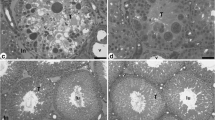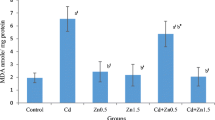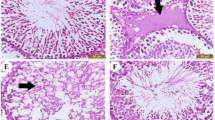Abstract
A single dose of cadmium chloride (3.23 μmol Cd2+/kg) causing acute testicular damage in male rats also caused significant creatinuria and creatinaemia at 48 h after dosing. Doses of cadmium which did not cause testicular necrosis did not cause creatinuria or creatinaemia. Surgical ligation of the pampiniform plexus also caused ischaemic necrosis of the testis and this was followed by significant creatinuria and creatinaemia. However, neither orchidectomy followed by a toxic dose of cadmium, orchidectomy alone nor sham operation caused significant creatinuria or creatinaemia. Cadmium dosing induced a temporary loss of body weight which was less than that caused by food restriction. Food restriction did not cause significant creatinuria but did cause significant creatinaemia. These data suggest that the creatine is derived from the damaged testis and that measurement of urinary creatine may be a useful non-invasive means of detecting acute testicular damage caused by exposure to chemicals or mechanical impairment of blood flow.
Similar content being viewed by others
References
Aoki A, Hoffer AP (1978) Reexamination of the lesions in rat testis caused by cadmium. Biol Reprod 18: 579–581
Berlin M, Ullberg S (1963) The fate of Cd109 in the mouse. An auto-radiographic study after a single intravenous injection of Cd109C12. Arch Environ Health 7: 686–693
Bernard A, Lauwerys R (1984) Cadmium in human populations Experientia 40: 143–152
Chellman GJ, Shaikh ZA, Baggs RB, Diamonds GL (1985) Resistance to cadmium-induced necrosis in testes of inbred mice: possible role of metallothionein-like cadmium-binding protein. Toxicol Appl Pharmacol 79: 511–523
Chiquoine AD (1964) Observations on the early events of cadmium necrosis of the testis. Anat Rec 149: 23–36
Delanghe J, de Buyzere M, de Sheerder I, Vogelaers D, Vandenbogaerde J, van den Abeere AM; Gheeraert P, Wieme R (1988) Creatine determinations as an early marker for the diagnosis of acute myocardial infarction. Clin Biochem 25: 383–388
Fuller NJ, Elia M (1988) Factors influencing the production of creatinine: implications for the determination and interpretation of urinary creatinine and creatine in man. Clin Chim Acta 175: 199–210
Gunn SA, Gould TC, Anderson WAD (1963) The selective injurious response of testicular and epididymal blood vessels to cadmium and its prevention by zync. Am J Pathol 42: 685–692
Gunn SA, Gould TC, Anderson WAD (1965) Comparative study of interstitial cell tumours of rat testis induced by cadmium injection and vascular ligation. J Natl Cancer Inst 35: 329–337
Hallenbeck WH (1984) Human health effects of exposure to cadmium. Experientia 40: 136–142
Johnson AD, Sigman MB (1971) Early actions of cadmium in the rat and domestic fowi testis. IV. Autoradiographic location of115m cadmium. J Reprod Fertil 24: 115–119
Kar AB, Das RP (1960) Testicular changes in rats after treatment with cadmium chloride. Acta Biol Med Ger 5: 153–173
Lee HJ, Filler WS, Iyengar MR (1988) Phosphocreatine, an intracellular high-energy compound, is found in the extracellular fluid of the seminal vesicles in mice and rats. Proc Natl Acad Sci USA 85: 7265–7269
Moore NP, Creasy DM, Gray TJB, Timbrell JA (1989a) Urinary creatine profiles after administration of cell specific testicular toxins to the rat. Proc V Internat Congress of Toxicology, no. 456: P 152
Moore NP, Gray TJB, Timbrell JA (1989b) The effect of two isomers of dinitrobenzene upon urinary creatine levels in the male rat. Hum Toxicol 8: 66–67
Moore NP, Timbrell JA, Gray TJB (1989c) Isolated rat seminiferous tubules synthesize guanidoacetic acid and creatine from arginine. Biochem Soc Trans 17: 520–521
Navon G, Gogol E, Weissenberg R (1985) Phosphorus-31 and proton NMR analysis of reproductive organs of male rats. Arch Androl 15: 153–157
Nicholson JK, Higham DP, Timbrell JA, Sadler PJ (1989) Quantitative high resolution1H-NMR urinalysis studies on the biochemical effects of cadmium in the rat. Mol Pharmacol 36: 398–404
Nordberg GF (1972) Cadmium metabolism and toxicity. Environ Physiol Biochem 2: 7–36
Ord MG, Stocken LA (1955) Creatine and carbohydrate metabolism. Biochem J 59: 272–279
Piscator M (1981) Role of cadmium in carcinogenesis with special reference to cancer of the prostate. Environ Health Perspect 40: 107–120
Rawcliffe L, Creasy DM, Timbrell JA (1989) Urinary creatine as a possible marker for testicular damage: studies with the testicular toxic compound 2-methoxyethanol. Reprod Toxicol 3: 269–274
Roe FJC, Dukes CE, Cameron MM, Pugh RCB, Mitchley BCV (1964) Cadmium neoplasia: testicular atrophy and Leydig cell hyperplasia and neoplasia in rats and mice following the subcutaneous injection of cadmium salt Br J Cancer 18: 674–681
Samarawickrama GP (1979) Biological effects of cadmium in mammals. In: Webb M (ed) The chemistry, biochemistry and biology of cadmium. Elsevier/North Holland Biomedical Press, Amsterdam, pp 341–421
Siedel J, Mollering H, Ziegenhorn J (1984) Sensitive color reagent for the enzymatic determination of creatinine. J Clin Chem 30: 968–969
Van Pilsum JF, Wolin EA (1958) Guanidium compounds in blood and urine of patients suffering from muscle disorders. J Lab Clin Med 51: 219–223
Waalkes MP, Poirier LA (1985) Interactions of cadmium with interstitial tissue of the rat testes. Uptake of cadmium by isolated interstitial cells. Biochem Pharmacol 34: 2513–2518
Waynforth HB (1980) Experimental and surgical technique in the rat. Academic Press, New York, London, p 160
Wong KL, Cachia R, Klaassen CD (1980) Comparison of the toxicity and tissue distribution of cadmium in newborn and adult rats after repeated administration. Toxicol Appl Pharmacol 56: 317–325
Author information
Authors and Affiliations
Additional information
Some of these data were presented at the British Toxicology Society meeting York, September 1986 (Human Toxicol 6: 402–403, 1987)
Rights and permissions
About this article
Cite this article
Gray, J., Nicholson, J.K., Creasy, D.M. et al. Studies on the relationship between acute testicular damage and urinary and plasma creatine concentration. Arch Toxicol 64, 443–450 (1990). https://doi.org/10.1007/BF01977625
Received:
Revised:
Accepted:
Issue Date:
DOI: https://doi.org/10.1007/BF01977625




